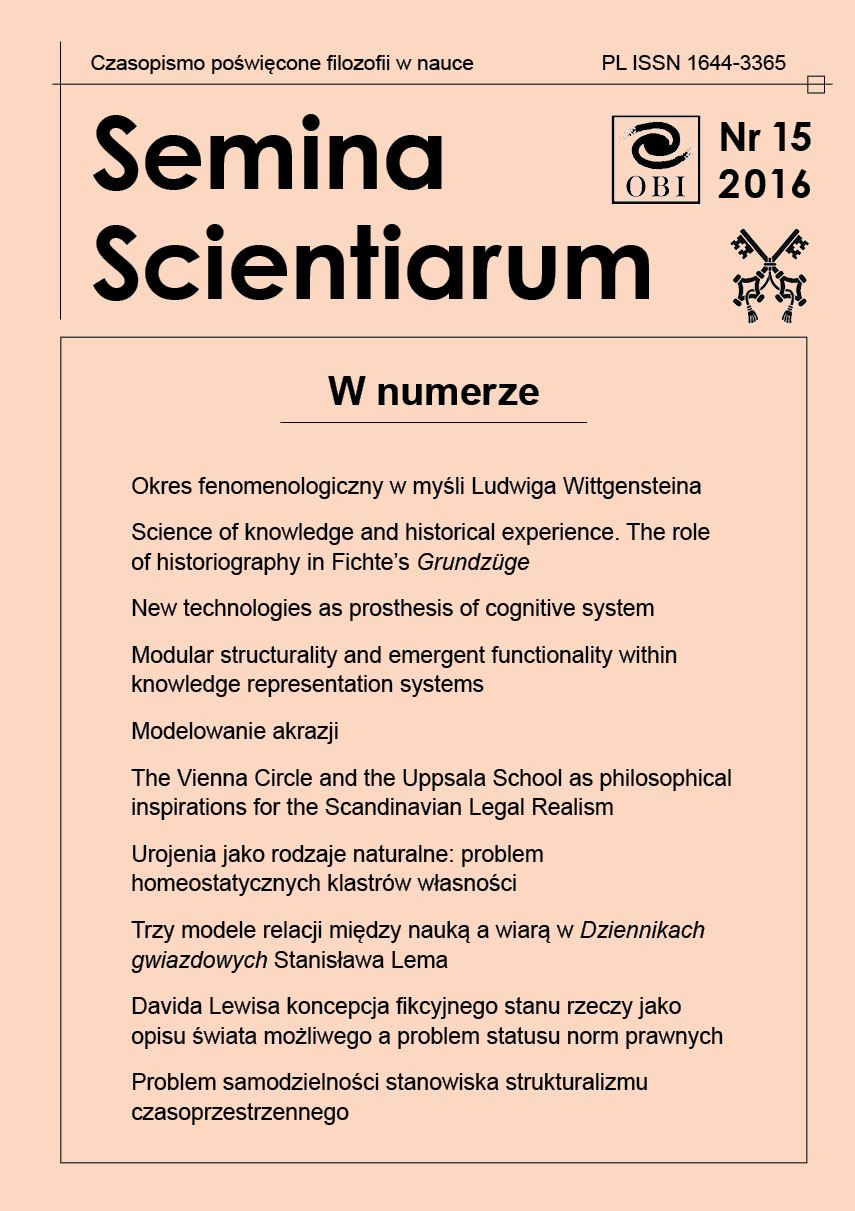Modular structurality and emergent functionality within knowledge representation systems
DOI:
https://doi.org/10.15633/ss.1769Słowa kluczowe:
metamodelling, ontology, proteomics, connectomics, centrality, philosophy of informationAbstrakt
There are various approaches to ontology metamodelling, and the notion of biologically inspired modular knowledge representation systems can provide insight in the workings of such phenomena as emergent properties of network structures. What is more relevant from knowledge engineering standpoint, such approach could provide innovation and enhancement of the level of expression as well as overall functionality of modular ontologies. To do so, one needs to find biological structures that would be the basis for modularity on different levels of hierarchy within the artificial system. Network analysis tools as well as systems biology and biocomputing provide a framework for research in this field.Bibliografia
Azam F., Biologically inspired modular neural networks, Blacksburg, VA 2000.
Behrens E. J., Sporns O., Human connectomics, “Current Opinion in Neurobiology” 22 (2011) 1, pp. 144–153.
Carruthers P., The architecture of mind, Oxford 2006
Cheng F. and others, Quantitative network mapping of the human kinome interactome reveals new clues for rational kinase inhibitor discovery and individualized cancer therapy, “Oncotarget” 15 (2014), p. 3697–3710, doi: 10.18632/oncotarget.1984.
Cornelis H., Coop A. D., Bower J. M., A federated design for a neurobiological simulation engine: the CBI Federated Software Architecture, “PloS One” (2012) 7 (1), doi: http://dx.doi.org/10.1371/journal.pone.0028956
Cornelis H. and others, Python as federation tool for GENESIS 3.0., “PloS One” (2012) 7 (1), doi: vhttp://dx.doi.org/10.1371/journal.pone.0029018.
Godwin D., Barry R. L., Marois R., Breakdown of the brain’s functional network modularity with awareness. “Proceedings of the National Academy of Sciences of USA” 112 (2015) 12, pp. 3799–3804, doi: 10.1073/pnas.1414466112.
Hagmann P., and others, Mapping the structural core of cerebral cortex, “PloS Biology” 6 (2008), doi: http://dx.doi.org/10.1371/journal.pbio.0060159.
Kennedy J., Eberhart R., Particle swarm optimization, Piscataway, NJ. 1995.
Kollia I. and others, Interweaving knowledge representation and adaptive neural networks, “Workshop on Inductive Reasoning and Machine Learning on the Semantic Web” (2009) 12, pp. 1–4.
Peng Y., Ontology mapping neural network: an approach to learning and inferring correspondences among ontologies, Pittsburgh 2010.
Roche C., Network analysis of Semantic Web Ontologies, Stanford CS224W: Social and Information Network Analysis 2011.
Zuo X. N., R and others, Network centrality in the human functional connectome, “Cerebral Cortex” 22 (2012) pp. 1862–1875, doi: 10.1093/cercor/bhr269.
Pobrania
Opublikowane
Numer
Dział
Licencja
Prawa autorskie (c) 2016 Adam Fedyniuk

Praca jest udostępniana na licencji Creative Commons Attribution-NonCommercial-NoDerivatives 3.0 Unported License.
Twórca oświadcza, że przysługują mu prawa autorskie do utworu i że nie są ograniczone w zakresie objętym niniejszym oświadczeniem oraz że utwór jest dziełem oryginalnym i nie narusza praw autorskich innych osób.
Twórca zezwala Uniwersytetowi Papieskiemu Jana Pawła II w Krakowie na nieodpłatne, niewyłączne i nieograniczone w czasie korzystanie z utworu, to jest:
- utrwalanie i zwielokrotnianie: wytwarzanie egzemplarzy utworu techniką drukarską, reprograficzną, zapisu magnetycznego oraz techniką cyfrową;
- obrotu oryginałem albo egzemplarzami, na których utwór utrwalono (wprowadzanie do obrotu, użyczenie lub najem oryginału albo egzemplarzy, publiczne wystawienie, wyświetlenie, a także publiczne udostępnianie utworu w taki sposób, aby każdy mógł mieć do niego dostęp w miejscu i w czasie przez siebie wybranym);
- włączenie utworu w skład utworu zbiorowego;
- udzielanie przez Uniwersytet Papieski Jana Pawła II w Krakowie sublicencji Creative Commons Uznanie autorstwa-Użycie niekomercyjne-Bez utworów zależnych 3.0 Polska
Uniwersytet Papieski Jana Pawła II w Krakowie udostępnia utwór na Platformie Czasopism należącej do uczelni, na licencji Creative Commons Uznanie autorstwa-Użycie niekomercyjne-Bez utworów zależnych 3.0 Polska. Tym samym uprawnia wszystkich zainteresowanych do korzystania z utworu pod następującymi warunkami:
- zostanie podany autor i tytuł utworu,
- zostanie podane miejsce publikacji (tytuł czasopisma i adres internetowy do oryginalnie opublikowanego utworu),
- utwór będzie dystrybuowany w sposób niekomercyjny,
- nie będą tworzone utwory zależne.

